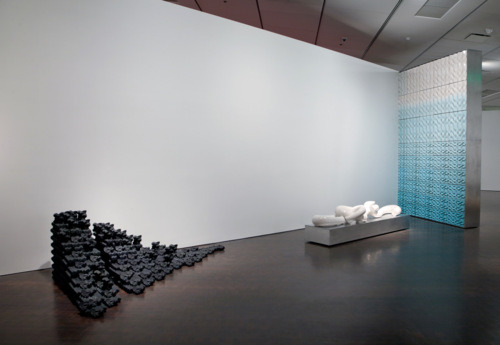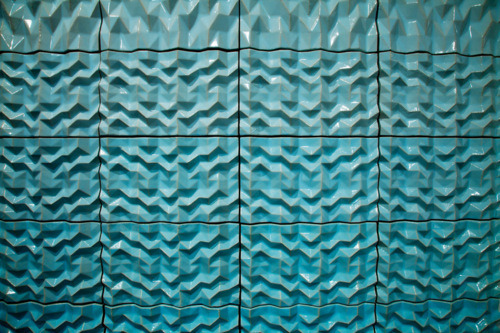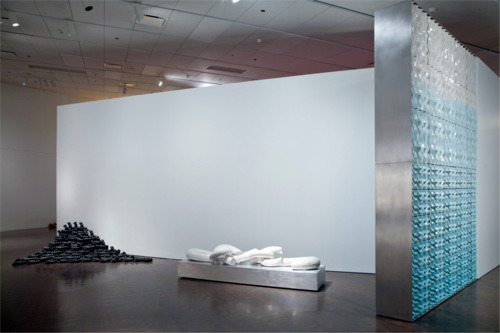
Del Harrow, Wedgewood Black Hive/Hole, 2011. Slip-cast black porcelain. / Links, 2011. Earthenware, glaze, and platinum luster. / Copper Fade, 2011. Earthenware and glaze. Photo by Jeff Wells.
The Hamilton Building at the Denver Art Museum responds to the natural landscape with carefully calibrated geometric volumes. I think of my installation as a kind of tapestry – or embroidery – embellishing this architecture with a more intricate structure.
Many of the qualities of ceramics make it ideal for large-scale architectural applications: it is permanent, colorful, and relatively simple to form. But clay also presents considerable challenges. It is fragile, heavy, and requires a kiln large enough to contain and carefully heat each component part.
For a thousand years architects have developed strategies for constructing large surfaces by connecting many clay pieces (The Sydney Opera House and the Alhambra are two of my personal favorites). Innovations in complex geometry have emerged from their solutions. Peter Lu, a Physicist and Harvard Professor, discovered the use of Penrose geometry in Medieval Iranian architecture. Penrose geometry – an idea not discovered in the wWestfor another 500 years – is a series of non-repeating tessellating polygons – in this case a functional solution for aligning ceramic tiles on a wall, and also a revelation as a component of fractal geometry; a mathematical concept for reflecting on form in nature.
While more modest in scale and complexity the components of this installation are borne out of the same impulse. The Hamilton Building at the Denver Art Museum is an ideal site. The building responds to the natural landscape with carefully calibrated geometric shapes. My installation is a second layer – a more intricate structure for weaving together the geometries of nature with the volumes of this architecture. The scale of the building and the significance of this exhibition have provided the catalyst for my largest and most ambitious work to date.
Tell us about the work you exhibited at the Overthrown: Clay Without Limits exhibition. What do they represent and what message do you want to deliver?
The work in this show was partly a response to the architecture of this building. The pieces deal with pattern, repetition, geometry, and difference. The textures and patterns that come from the many stages and layers of the process of making something with clay. I don’t have a particular message that I want to deliver.
Have you ever attempted to create a new material or to replicate a texture of a material in order to make your installations more exclusive?
I do think a lot about the qualities and textures of materials but I don’t think I’m trying to make the installations more “exclusive”. I think of my use of materials as pretty inclusive or democratic. My installations are compositions, there are a lot of different metaphors I use to think about their structure – music and cooking are a couple – so I’m thinking about creating an experience that comes out of a play with repetition and difference. Material qualities are one layer of the composition.
There is a chapter in Baudrillard’s book “The System of Objects” called “Natural Wood and Cutural Wood” where he discusses the cultural hierarchies of various materials. For example vinyl siding imprinted with a wood grain is typically assigned a lower position in the hierarchy of materials that natural wood siding even though the vinyl siding probably performs it’s function better (of course Baudrillard also wrote this book in the 1960‘s before we were aware of some of the health risks of “off gassing” from too much plastic in building materials). We also have an aesthetic experience of material qualities. Man made materials tend to have more uniformity in their pattern and texture. I don’t see one type of material – synthetic or natural – as inherently superior and I think that even the line between the two categories is pretty fuzzy. Ceramic materials have a long history of borrowing qualities and textures and even mimicking other materials. For example Terra Cotta Building cladding made to imitate stone, or pots that borrow texture from basketry or metal work. Certain ceramic materials also have very strong – and sometimes paradoxical – cultural associations. “Porcelain” still has associations with ideas of quality, purity, exclusivity, and at the same time it can feel nostalgic, kitsch, and low brow. I’m very interested in these ideas and I see my work as playing within this territory.

Del Harrow, Copper Fade, 2011. Earthenware and glaze. Photo by Jeff Wells.
What is your reaction towards using plastic plates and cutlery in our daily life?
I don’t know if I’ve ever come a across a plastic knife and fork and thought: “this is a really nice thing to use”. I wish I would. Cheap, disposable knives and forks certainly serve a function. I don’t use them very often but at picnics they are pretty handy. I wish the knives didn’t always break when you’re trying to cut your steak. They should also be biodegradable.
If you would have to recreate the nomadic Brancusi exhibition, what other object would you add that could empathize with the philosophy of the famous Romanian sculptor?
When I made that piece it started out as an idea about reproduction of objects and authorship. As I was working and started doing more research I became more interested in Brancusi’s ideas about his sculptures being dependent on specific spatial relationships to each other and on the architecture of his studio space. Along with his work making discreet forms/sculptures Brancusi had a parallel practice of photographing the work within the space/context of the studio. The composition of objects in my piece was based on a specific arrangement from one of his photographs. I chose a picture that contained several very iconic forms: bird in space, endless column… I think if I made this piece again it might be interesting to chose a photograph with less well known forms. Some of his photographs are just piles of molds and raw materials in a corner of the room. In some ways these types of photographs make more space for thinking about his objects as provisional and contingent on qualities of light, context, and arrangement.

Del Harrow, Wedgewood Black Hive/Hole, 2011. Slip-cast black porcelain. / Links, 2011. Earthenware, glaze, and platinum luster. / Copper Fade, 2011. Earthenware and glaze. Photo by Jeff Wells.
Where can we find you and your works in the next future?
I have a couple of exhibitions coming up, one in November at Vox Populi Gallery in Philadelphia. This show will be the result of a collaboration with Chadwick Augustine. I also have a solo show opening in February at Texas State University in San Marcos, Texas.
“My current studio practice consists of two activities: the production/fabrication of objects from a range of materials, and then, a sustained investigation of these objects by way of successive experiments with strategies for placement, arrangement, and organization.
Individual objects emerge from a confluence of form, material and process. Many sculptures begin as digital models – employing computer software as a tool for generating abstract form. As material culture an objects’ subtle textures and marks contain and reveal information about methods of fabrication – manual or mechanized production – and by extension the scale of economy, culture, and the objects meaning within it.
Objects within an installation are built on a range of scales – of objects, furniture, architectural fragments – creating a composite scale/space, shifting between the miniature, the architectural interior, and the landscape.
Installations borrow organizational strategies from both art historical compositions and vernacular spaces: game fields, farms, domestic interiors, forests. These spaces share abstract forms: planes, mesh-works, surfaces, and hierarchies. Like a mathematical model or interior architecture, the installation is a diagrammatic construction built within the gallery.” Del Harrow
Visit Del Harrow’s website.
By Iunia Ratiu.
Published in Ceramics Now Magazine Issue 1.



















